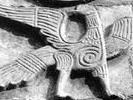The Hamilton and Norwood male pattern baldness classification systems are comprehensive and involve several stages. However, the distinction between the different patterns is not always clear - particularly for patients who may not be familiar with classification systems.
Some European dermatology clinics use a simpler five stage classification system developed by Rook and Ebling. This system is rarely used in medical research as it is not detailed enough, but the five stage classification is useful for explaining hair loss to patients. This simplified classification is easier to comprehend. In addition, Ebling developed several classifications for particular ethnic groups and these may be more relevant to some patients than the Hamilton and Norwood "catch-all" classifications.
The Mediterranean or Latin development of pattern baldness involves recession of the frontal hairline and the development of vertex baldness. These two regions of hair loss expand and coalesce into the extensive type V pattern.

The Semitic (Jewish, Arabian) presentation of pattern alopecia involves progressive recession of the frontal hairline but there is no associated thinning on the vertex according to Ebling.

The Nordic presentation with a central lock of surviving hair was noted by Norwood in the development of his classification system. Ebling suggested the five stage system for Nordic races as shown below.

Are men with pattern alopecia physically more masculine references
Norwood OT. Male pattern baldness: classification and incidence. South Med J. 1975 Nov;68.
Hamilton JB. Patterned loss of hair in man: types and incidence. Ana N Y Acad Dermatol 1951.
 Вход
Вход Зарегистрироваться
Зарегистрироваться






 Наверх
Наверх



























